
Claude and Starck was an architectural firm in Madison, Wisconsin, at the turn of the twentieth century. The firm was a partnership of Louis W. Claude (1868-1951) and Edward F. Starck (1868-1947). Established in 1896, the firm dissolved in 1928. The firm designed over 175 buildings in Madison.
The John Hunter House, also known as McCullough House, near Franklin, Tennessee is an Italianate style house that was built in 1875. It was listed on the National Register of Historic Places (NRHP) in 1988.
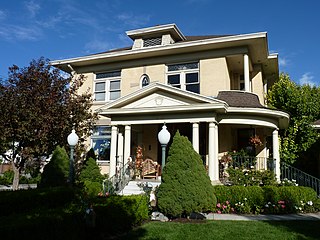
The Thomas N. Taylor House is a historic house located at 342 North 500 West in Provo, Utah. It is listed on the National Register of Historic Places.

The John R. Twelves House is a historic house located in Provo, Utah, United States. It is listed on the National Register of Historic Places.

The Knight–Allen House is a historic house located in Provo, Utah. It is listed on the National Register of Historic Places.

The Biederstatedt Grocery, later Breitenbach Grocery, was built in 1874 in Madison, Wisconsin as a corner grocery store. It is the best-preserved survivor of the corner groceries that once dotted Madison. In 1982 it was added to the National Register of Historic Places.

The James B. Bowen House is an early Italianate-styled house clad in cut sandstone, built in 1855 on what was then a farm on the outskirts of Madison, Wisconsin. In 1982 it was added to the National Register of Historic Places.
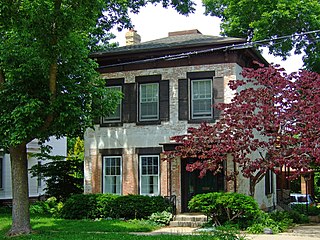
Hyer's Hotel is the oldest surviving urban hotel building in Madison, Wisconsin. Built in 1854 a half mile east of the capitol, it was added in 1983 to the National Register of Historic Places.
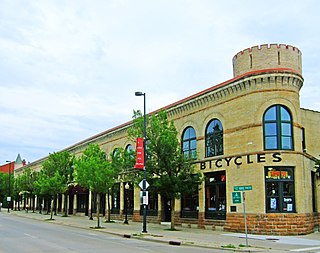
Machinery Row is a long brick commercial block a half mile east of the capitol in Madison, Wisconsin. It was built in stages from about 1898 to 1914 to house businesses that wanted good access to the east-side railroad depots. Many of the businesses housed in the block distributed agricultural implements, hence "Machinery" in the name. In 1982 the block was added to the National Register of Historic Places.

The Mansion Hill Historic District encompasses a part of the Mansion Hill neighborhood northwest of the capitol square in Madison, Wisconsin. In the 19th century the district was home to much of Madison's upper class, and held the largest concentration of large, ornate residences in the city, but in the 20th century it shifted to student housing. In 1997 the district was added to the National Register of Historic Places.

The Marquette Bungalows Historic District is part of a neighborhood developed from 1924 to 1930 on the isthmus of Madison, Wisconsin, United States, holding the largest group of Craftsman-style bungalows in the city. In 1997 the district was added to the National Register of Historic Places.
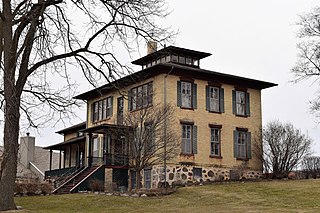
The Ferdinand C. Hartwig House is a historic house located at 908 Country Lane in Watertown, Wisconsin. It was added to the National Register of Historic Places on June 17, 1982.

The La Crosse Commercial Historic District is located in downtown La Crosse, Wisconsin. It includes over ninety contributing structures, mostly 2-3 story commercial brick buildings constructed from the 1860s to the 1940s. The district is roughly bounded by Jay Street, Second Street South, State Street, and Fifth Avenue South.

The East Wilson Street Historic District includes remnants of businesses that grew around two railroad depots a half mile east of the capitol in Madison, Wisconsin, starting in the 1860s. A cluster of the hotel and saloon buildings from this district are still fairly intact, in contrast to Madison's other railroad station on West Washington. In 1986 the district was listed on the National Register of Historic Places and the State Register of Historic Places in 1989.

The Jenifer-Spaight Historic District is a historic neighborhood a mile east of the capitol in Madison, Wisconsin, including houses built as early as 1854. In 2004 the district was added to the National Register of Historic Places (NRHP).
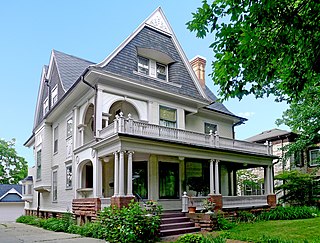
The Timothy C. and Katherine McCarthy House is a grand 2.5-story Queen Anne-styled house a mile east of the capitol square in Madison, Wisconsin, United States, built in 1897 for prominent contractor McCarthy, whose firm would build much of the current Wisconsin State Capitol. In 2002 McCarthy's house was added to the National Register of Historic Places.
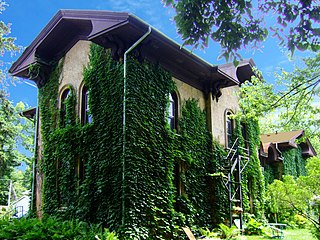
The Simeon Mills House is an Italianate-style farmhouse-mansion built in 1863 on the east side of Madison, Wisconsin for Mills, an early settler, businessman and prominent civic leader. In 1987 this, his country house, was added to the National Register of Historic Places.

The Simeon Mills Historic District is a group of seven historic commercial buildings two blocks west of the capitol square in Madison, Wisconsin, constructed from around 1845 to 1887. In 1987 the district was added to the National Register of Historic Places - considered significant for its concentration of 19th century commercial buildings, which is unique in Madison.

The Orton Park Historic District is a residential historic district on the near east side of Madison, Wisconsin. The district is centered on Orton Park, the first public park in Madison, and includes 56 houses facing or near to the park. The first houses in the area were built in the 1850s during a local housing boom; however, after the Panic of 1857 ended the boom, development in the area halted. When Orton Park was developed out of a former cemetery in the 1880s, more houses were built near the park; construction in the district continued through the 1950s. Many houses in the district were designed in the Queen Anne, Prairie School, and Craftsman styles, and local architects Claude and Starck designed at least seven houses in the district. The district also includes examples of Greek Revival, Italianate, and Colonial Revival architecture.

The Old World Third Street Historic District is the last relatively intact part of the original German retail district in Kilbourntown plat in Milwaukee, Wisconsin, United States. It contains examples of various styles of Victorian commercial architecture going back to 1855. It was listed on the National Register of Historic Places in 1987 and on the State Register of Historic Places in 1989.






















